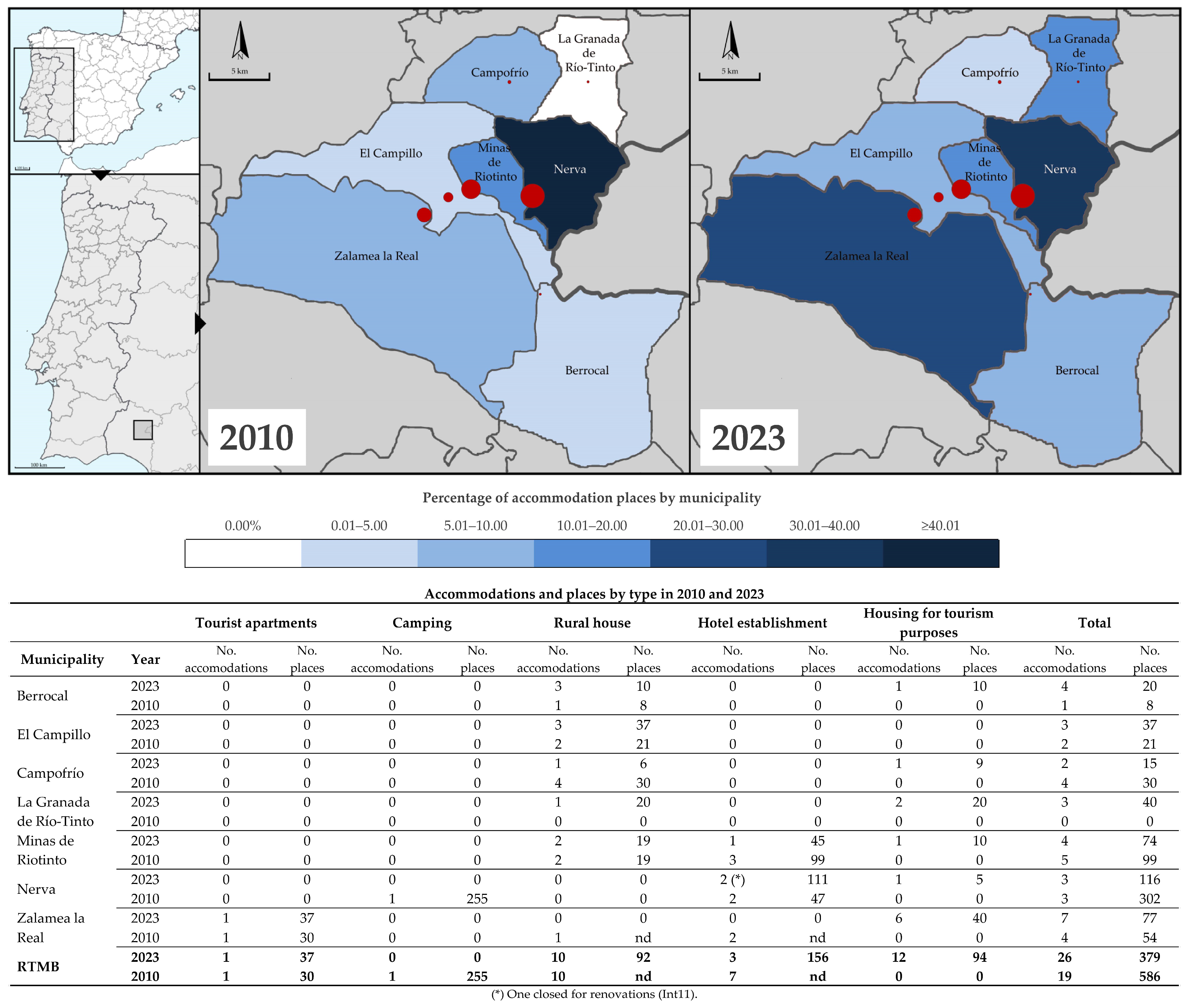The Contribution of Tourism to Sustainable Rural Development in Peripheral Mining Spaces: The Riotinto Mining Basin (Andalusia, Spain)
Abstract
1. Introduction
- The importance of the whole and the uniqueness, because not all mining sites are accepted by tourists in the same way [6].
- Substantial continuous public investments are necessary to cover the vital implementation costs, i.e., IMH rehabilitation, tourism value enhancement, and use and maintenance [16,53], particularly when these public funds and investments are withdrawn during the crisis [14,53], and there is a need for private investment.
2. Materials and Methods
2.1. Methodology
2.2. Scope of Study
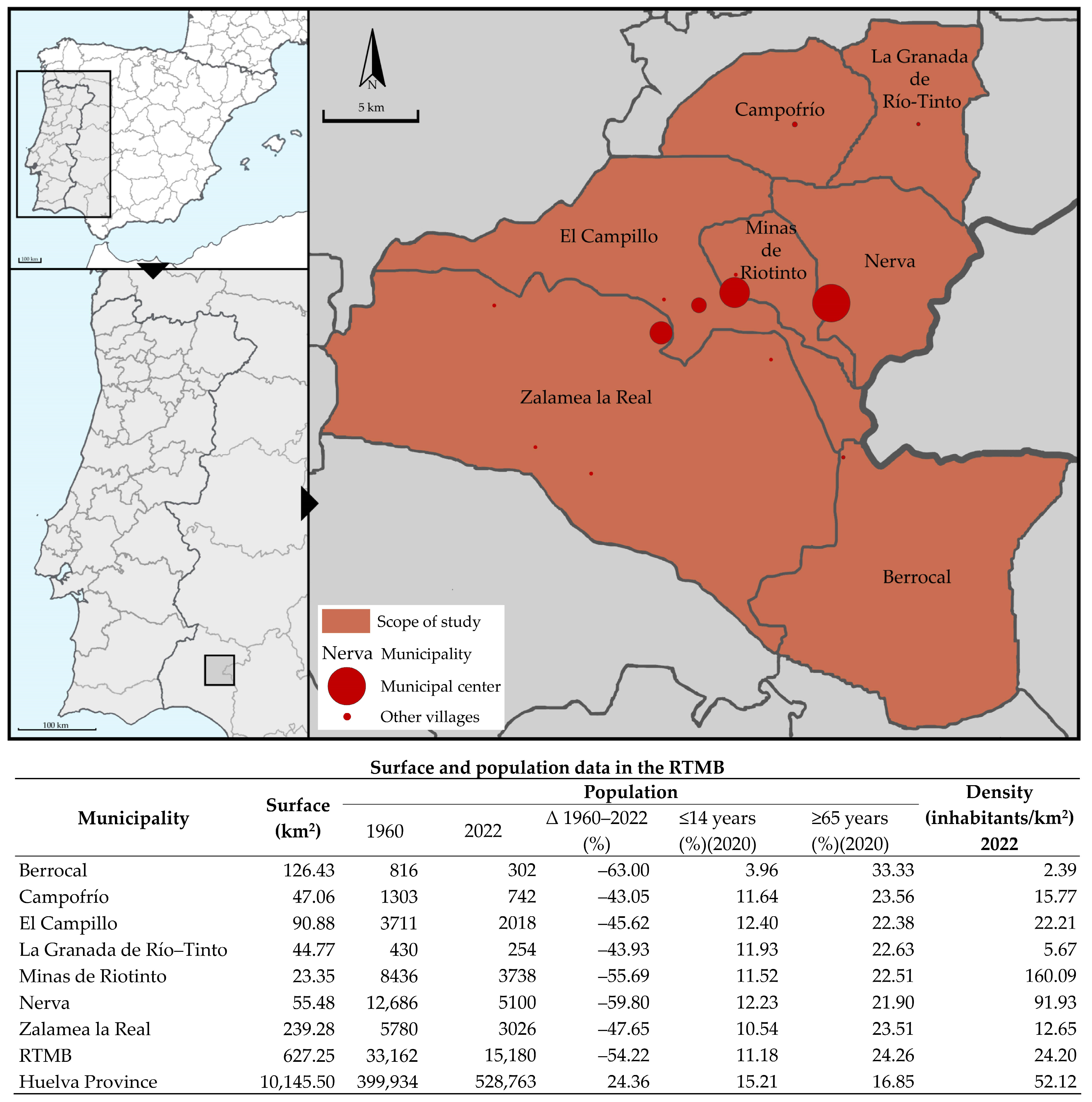
3. Results and Discussion
3.1. Responses to the Mining Crisis
3.2. The Tourist Value of Mining Heritage
3.3. Change of Scenery
3.4. Tourism and Sustainable Rural Development Processes
3.4.1. Socio-Cultural Dimension
3.4.2. Economic Dimension
3.4.3. Environmental Dimension
3.4.4. Political–Institutional Dimension
4. Conclusions
Author Contributions
Funding
Institutional Review Board Statement
Informed Consent Statement
Data Availability Statement
Acknowledgments
Conflicts of Interest
Abbreviations
| ACI | Asset of Cultural Interest. |
| ARF | Atalaya Riotinto Foundation. |
| CSR | Corporate Social Responsibility. |
| EAFRD | European Agricultural Fund for Rural Development. |
| ERDF | Regional Development Fund. |
| ERIH | European Route of Industrial Heritage. |
| ESF | European Social Fund. |
| HZRTN | Heritage Zone of the Riotinto–Nerva Mining Zone. |
| IMH | Industrial Mining Heritage. |
| IMHT | Industrial Mining Heritage Tourism |
| Int01, Int02… | Interviews. |
| LAG | Local Action Group. |
| MGMN | Montera de Gossan Natural Monument. |
| MTR | Mining Tourist Railway. |
| PLRT | Protected Landscape of Rio Tinto. |
| q1, q2… | Interview questions. |
| RTF | Rio Tinto Foundation. |
| RTMB | Rio Tinto Mining Basin. |
| RTMM | Rio Tinto Mining Museum. |
| RTMP | Rio Tinto Mining Park. |
| SIE | Services, Infrastructure, and Equipment. |
| SRD | Sustainable Rural Development. |
| WHS | World Heritage Site. |
References
- Avango, D.; Rosqvist, G. When mines go silent: Exploring the afterlives of extraction sites. In Nordic Perspectives on the Responsible Development of the Arctic: Pathways to Action; Nord, D.C., Ed.; Springer: Cham, Swizerland, 2021; pp. 349–367. [Google Scholar]
- Somoza-Medina, X.; Monteserín-Abella, O. The sustainability of industrial heritage tourism far from the axes of economic development in Europe: Two case studies. Sustainability 2021, 13, 1077. [Google Scholar] [CrossRef]
- Heldt-Cassel, S.; Pashkevich, A. Heritage tourism and inherited institutional structures: The case of Falun Great Copper Mountain. Scand. J. Hosp. Tour. 2011, 11, 54–75. [Google Scholar] [CrossRef]
- Lintz, G.; Wirth, P.; Harfst, J. Regional Structural Change and Resilience. Raumforsch. Raumordn. 2012, 70, 365–373. [Google Scholar] [CrossRef]
- Benito-del-Pozo, P. Patrimonio industrial y Cultura del Territorio. Bol. Asoc. Geogr. Esp. 2002, 1, 213–227. [Google Scholar]
- Edwards, J.A.; Llurdés-i-Coit, J.C. Mines and quarries: Industrial heritage tourism. Ann. Tour. Res. 1996, 23, 341–363. [Google Scholar] [CrossRef]
- Cañizares-Ruiz, M.C. El atractivo turístico de una de las minas de mercurio más importantes del mundo: El parque minero de Almadén (Ciudad Real). Cuad. Tur. 2008, 21, 9–31. [Google Scholar]
- Llurdés-i-Coit, J.C. Patrimonio industrial y Patrimonio de la Humanidad. El ejemplo de las Colonias Textiles Catalanas. Potencialidades turísticas y algunas reflexiones. Bol. Asoc. Geogr. Esp. 1999, 28, 147–160. [Google Scholar]
- Ćopić, S.; ĐorđevićA, J.; Lukić, T.; Stojanović, V.; Đukičin, S.; Besermenji, S.; Tumarić, A. Transformation of industrial heritage: An example of tourism industry development in the Ruhr area (Germany). Geogr. Pannonica 2014, 18, 43–50. [Google Scholar] [CrossRef]
- Hospers, G.J. Restructuring Europe’s rustbelt: The case of the German Ruhrgebiet. Intereconomics 2004, 39, 147–156. [Google Scholar] [CrossRef]
- Avango, D.; Lépy, É.; Brännström, M.; Heikkinen, H.; Komu, T.; Pashkevich, A.; Österlin, C. Heritage for the future: Narrating abandoned mining sites. In Resource Extraction and Arctic Communities: The New Extractivist Paradigm; Sörlin, S., Ed.; Cambridge University Press: Cambridge, UK, 2022; pp. 206–228. [Google Scholar]
- Price, W.R.; Rhodes, M.A. Coal dust in the wind: Interpreting the industrial past of South Wales. Tour. Geogr. 2022, 24, 837–858. [Google Scholar] [CrossRef]
- Maciejewska, A.; Kuzak, Ł.; Sobieraj, J.; Metelski, D. The Impact of Opencast Lignite Mining on Rural Development: A Literature Review and Selected Case Studies Using Desk Research, Panel Data and GIS-Based Analysis. Energies 2022, 15, 5402. [Google Scholar] [CrossRef]
- Lusso, B. Patrimonialisation et greffes culturelles sur des friches issues de l’industrie minière. Regards croisés sur l’ancien bassin minier du Nord-Pas de Calais (France) et la vallée de l’Emscher (Allemagne). EchoGéo 2013, 26. [Google Scholar] [CrossRef]
- Valenzuela-Rubio, M.; Palacios-García, A.J.; Hidalgo-Giralt, C. La valorización turística del patrimonio minero en entornos rurales desfavorecidos: Actores y experiencias. Cuad. Tur. 2008, 22, 231–260. [Google Scholar]
- Hidalgo-Giralt, C. El Proceso de Valorización Turística del Patrimonio Minero. Un Análisis de los Agentes Involucrados y de las Políticas Implementadas. Ph.D. Thesis, University Carlos III de Madrid, Madrid, Spain, 2010. [Google Scholar]
- Cañizares-Ruiz, M.C. Patrimonio, Minería y Rutas en el Valle de Alcudia y Sierra Madrona (Ciudad Real). Estud. Geográficos 2013, 74, 409–437. [Google Scholar] [CrossRef]
- Jansen-Verbeke, M. Industrial heritage: A nexus for sustainable tourism development. Tour. Geogr. 1999, 1, 70–84. [Google Scholar] [CrossRef]
- Llurdés-i-Coit, J.C.; Saurí-Pujol, D.; Cerdán-Heredia, R. Conflictos locacionales en territorios en crisis. Turismo y residuos en Cardona (Barcelona). An. Geogr. Univ. Complut. 1999, 19, 119–140. [Google Scholar]
- Harfst, J.; Sandriester, J.; Fischer, W. Industrial heritage tourism as a driver of sustainable development? A case study of Steirische Eisenstrasse (Austria). Sustainability 2021, 13, 3857. [Google Scholar] [CrossRef]
- Capel-Sáez, H. La rehabilitación y el uso del patrimonio histórico industrial. Doc. D’análisis Geogràfica 1996, 29, 19–50. [Google Scholar]
- Cueto-Alonso, G.J. Nuevos usos turísticos para el patrimonio minero en España. PASOS 2016, 14, 1013–1026. [Google Scholar] [CrossRef]
- Szromek, A.R.; Herman, K. A Business Creation in Post-Industrial Tourism Objects: Case of the Industrial Monuments Route. Sustainability 2019, 11, 1451. [Google Scholar] [CrossRef]
- Caamaño-Franco, I.; Andrade-Suárez, M. The value assessment and planning of industrial mining heritage as a tourism attraction: The case of Las Médulas cultural space. Land 2020, 9, 404. [Google Scholar] [CrossRef]
- Deng, L.H.; Zou, F.H. Geotourism and geoparks for sustainable rural development and poverty alleviation: Huanggang Dabieshan UNESCO Global Geopark, China. Aust. J. Earth Sci. 2022, 69, 286–301. [Google Scholar] [CrossRef]
- Cañizares-Ruiz, M.C. Visibilidad y promoción del patrimonio minero en algunos geoparques españoles. Doc. D’anàlisi Geogràfica 2020, 66, 109–131. [Google Scholar] [CrossRef]
- Pashkevich, A. Processes of reinterpretation of mining heritage: The case of Bergslagen, Sweden. Almatourism-J. Tour. Cult. Territ. Dev. 2017, 8, 107–123. [Google Scholar]
- Andrade-Suárez, M.; Caamaño-Franco, I. Theoretical and methodological model for the study of social perception of the impact of industrial tourism on local development. Soc. Sci. 2018, 7, 217. [Google Scholar] [CrossRef]
- Cañizares-Ruiz, M.C.; Benito-del-Pozo; Pascual-Ruiz-de-Valdepeñas, H. Los límites del turismo industrial en áreas desfavorecidas. Cuad. Geogr. 2019, 58, 180–204. [Google Scholar]
- Ruiz-Ballesteros, E.; Hernández-Ramírez, M. Identity and community—Reflections on the development of mining heritage tourism in Southern Spain. Tour. Manag. 2007, 28, 677–687. [Google Scholar] [CrossRef]
- Du-Cros, H. A new model to assist in planning for sustainable cultural heritage tourism. Int. J. Tour. Res. 2001, 3, 165–170. [Google Scholar] [CrossRef]
- Aas, C.; Ladkin, A.; Fletcher, J. Stakeholder collaboration and heritage management. Ann. Tour. Res. 2005, 32, 28–48. [Google Scholar] [CrossRef]
- García-Delgado, F.J.; Martínez-Puche, A.; Lois-González, R.C. Heritage, Tourism and Local Development in Peripheral Rural Spaces: Mértola (Baixo Alentejo, Portugal). Sustainability 2020, 12, 9157. [Google Scholar] [CrossRef]
- Mitchell, C.J.A. Entrepreneurialism, commodification and creative destruction: A model of post-modern community development. J. Rural. Stud. 1998, 14, 273–286. [Google Scholar] [CrossRef]
- George, E.W.; Reid, D.G. The power of tourism: A metamorphosis of community culture. J. Tour. Cult. Chang. 2005, 3, 88–107. [Google Scholar] [CrossRef]
- Timothy, D.J.; Boyd, S.W. Heritage tourism in the 21st century: Valued traditions and new perspectives. J. Herit. Tour. 2006, 1, 1–16. [Google Scholar] [CrossRef]
- Bangstad, T.R. Routes of Industrial Heritage: On the Animation of Sedentary Objects. Cult. Unbound 2011, 3, 279–295. [Google Scholar] [CrossRef]
- Heldt-Cassel, S.; Pashkevich, A. World Heritage and tourism innovation: Institutional frameworks and local adaptation. Eur. Plan. Stud. 2014, 22, 1625–1640. [Google Scholar] [CrossRef]
- Acheson, C.R. Visiting the Industrial Revolution: The Communication of World Heritage Values to Tourists in Ironbridge Gorge. Ph.D. Thesis, University of Birmingham, Birmingham, UK, 2019. [Google Scholar]
- Pardo-Abad, C.J. The post-industrial landscapes of Riotinto and Almadén, Spain: Scenic value, heritage and sustainable tourism. J. Herit. Tour. 2017, 12, 331–346. [Google Scholar] [CrossRef]
- Wanhill, S. Mines—A tourist attraction: Coal mining in industrial South Wales. J. Travel Res. 2000, 39, 60–69. [Google Scholar] [CrossRef]
- Blockley, M. Developing a Management Plan for the Ironbridge Gorge World Heritage Site. In Archaeology and the National Park Idea: Challenges for Management and Interpretation; George Wright Society: Hancock, MI, USA, 1999; pp. 107–120. [Google Scholar]
- Otgaar, A.H.J. Towards a common agenda for the development of industrial tourism. Tour. Manag. Perspect. 2012, 4, 86–91. [Google Scholar] [CrossRef]
- Rutherford-Morrison, L. Playing Victorian: Heritage, Authenticity, and Make-Believe in Blists Hill Victorian Town, the Ironbridge Gorge. Public Hist. 2015, 37, 76–101. [Google Scholar] [CrossRef]
- Dicks, B. Performing the hidden injuries of class in coal-mining heritage. Sociology 2008, 42, 436–452. [Google Scholar] [CrossRef]
- Kesküla, E. Reproducing Labor in the Estonian Industrial Heritage Museum. J. Baltic Stud. 2013, 44, 229–248. [Google Scholar] [CrossRef]
- Coupland, B.; Coupland, N. The authenticating discourses of mining heritage tourism in Cornwall and Wales. J. Socioling. 2014, 18, 495–517. [Google Scholar] [CrossRef]
- Richards, G. The experience industry and the creation of attractions. In Cultural Attractions and European Tourism; Richards, G., Ed.; CABI: Wallinford, UK, 2001; pp. 55–69. [Google Scholar]
- Napierała, T.; Leśniewska-Napierała, K.; Nalej, M.; Pielesiak, I. Co-evolution of tourism and industrial sectors: The case of the Bełchatów industrial district. Eur. Spat. Res. Policy 2022, 29, 149–173. [Google Scholar] [CrossRef]
- Conlin, M.V.; Bird, G.R. (Eds.) Railway Heritage and Tourism: Global Perspectives; Channel View Publications: Bristol, UK, 2014. [Google Scholar]
- Hospers, G.J. Industrial heritage tourism and regional restructuring in the European Union. Eur. Plan. Stud. 2002, 10, 397–404. [Google Scholar] [CrossRef]
- Cole, D. Exploring the Sustainability of Mining Heritage Tourism. J. Sustain. Tour. 2004, 12, 480–494. [Google Scholar] [CrossRef]
- Boros, L.; Martyin, Z.; Pàl, V. Industrial tourism-trends and opportunities. Forum Geogr. 2013, 12, 108–114. [Google Scholar] [CrossRef]
- Barrado-Timón, D.; Hidalgo-Giralt, C.; Palacios-García, A. Despoblación y envejecimiento en las zonas mineras. ¿Es el turismo una solución? Casos de Riotinto (Huelva) y La Pernía-Barruelo (Palencia). In Despoblación, Envejecimiento y Territorio: Un Análisis Sobre la Población Española; XI Congreso de la Población Española, León, Spain, September 2008; López-Trigal, L., Abellán-García, A., Godenau, D.C., Eds.; Universidad de León: León, Spain, 2009; pp. 629–641. [Google Scholar]
- Jakobsson, M. Från Industrier till Upplevelser: En Studie av Symbolisk och Materiell Omvandling i Bergslagen. Ph.D. Thesis, Örebro Universitet, Örebro, Sweden, 2009. [Google Scholar]
- Carson, D.A.; Carson, D.B.; Lundmark, L. Tourism and mobilities in sparsely populated areas: Towards a framework and research agenda. Scand. J. Hosp. Tour. 2014, 14, 353–366. [Google Scholar] [CrossRef]
- Carson, D.A. Challenges and opportunities for rural tourism geographies: A view from the ‘boring’peripheries. Tour. Geogr. 2018, 20, 737–741. [Google Scholar] [CrossRef]
- Prideaux, B. Building visitor attractions in peripheral areas-Can uniqueness overcome isolation to produce viability? Int. J. Tour. Res. 2002, 4, 379–389. [Google Scholar] [CrossRef]
- Ramsey, D.; Malcolm, C.D. The importance of location and scale in rural and small town tourism product development: The case of the Canadian Fossil Discovery Centre, Manitoba, Canada. Can. Geogr.-Geogr. Can. 2017, 62, 250–265. [Google Scholar] [CrossRef]
- Hardy, A. Understanding self drive tourism. Rubber tire traffic: A case study of Bella Cool, British Columbia. In Informed Leisure Practice: Cases as Conduits Between Theory and Practice; Vaugenois, N.L., Ed.; Malaspina University-College: Nanaimo, BC, Canada, 2006; Volume 2, pp. 46–51. [Google Scholar]
- Simoncini, R.; De-Groot, R.; Pinto-Correia, T. An integrated approach to assess options for multi-functional use of rural areas: Special issue “Regional Environmental Change”. Reg. Environ. Chang. 2009, 9, 139–141. [Google Scholar] [CrossRef]
- Ray, C. Towards a meta-framework of endogenous development: Repertoires, paths, democracy and rights. Sociol. Rural. 1999, 39, 521–537. [Google Scholar] [CrossRef]
- Ravazzoli, E.; Valero-López, D.E. Social Innovation: An Instrument to Achieve the Sustainable Development of Communities. In Sustainable Cities and Communities. Encyclopedia of the UN Sustainable Development Goals; Leal Filho, W., Azul, A., Brandli, L., Özuyar, P., Wall, T., Eds.; Springer: Cham, Switzerland, 2020. [Google Scholar]
- Belliggiano, A.; Cejudo-García, E.; Labianca, M.; Navarro-Valverde, F.; De-Rubertis, S. The “Eco-Effectiveness” of Agritourism Dynamics in Italy and Spain: A Tool for Evaluating Regional Sustainability. Sustainability 2020, 12, 7080. [Google Scholar] [CrossRef]
- Lichrou, M.; O’malley, L. Mining and tourism: Conflicts in the marketing of Milos Island as a tourism destination. Tour. Hosp. Plan. Dev. 2006, 3, 35–46. [Google Scholar] [CrossRef]
- Dwyer, L.; Pham, T.; Jago, L.; Bailey, G.; Marshall, J. Modeling the impact of Australia’s mining boom on tourism: A classic case of Dutch disease. J. Travel Res. 2016, 55, 233–245. [Google Scholar] [CrossRef]
- Rudd, M.A.; Davis, J.A. Industrial heritage tourism at the Bingham Canyon copper mine. J. Travel Res. 1998, 36, 85–89. [Google Scholar] [CrossRef]
- Pardo-Abad, C.J. Indicadores de sostenibilidad turística aplicados al patrimonio industrial y minero: Evaluación de resultados en algunos casos de estudio. Bol. Asoc. Geogr. Esp. 2014, 65, 11–36. [Google Scholar] [CrossRef]
- Yin, R.K. Case Study Research and Applications: Design and Methods, 6th ed.; Sage: Los Angeles, CA, USA, 2018. [Google Scholar]
- Kitchen, R.; Tate, N.J. Conducting Research into Human Geography; Pearson: Essex, UK, 2000. [Google Scholar]
- Saxena, G.; Ilbery, B. Developing integrated rural tourism: Actor practices in the English/Welsh border. J. Rural Stud. 2010, 26, 260–271. [Google Scholar] [CrossRef]
- Hardy, A. Using grounded theory to explore stakeholder perceptions of tourism. J. Tour. Cult. Chang. 2005, 3, 108–133. [Google Scholar] [CrossRef]
- Longhurst, R. Semi-structured interviews and focus groups. In Key Methods in Geography, 2nd ed.; Clifford, N., French, S., Vallentine, G., Eds.; Sage: London, UK, 2010; pp. 103–115. [Google Scholar]
- Bahamonde-Rodríguez, M.; García-Delgado, F.J.; Šadeikaitė, G. Sustainability and Tourist Activities in Protected Natural Areas: The Case of Three Natural Parks of Andalusia (Spain). Land 2022, 11, 2015. [Google Scholar] [CrossRef]
- García-Delgado, F.J.; Delgado-Domínguez, A.; Felicidades-García, J. El turismo en la cuenca minera de Riotinto. Cuad. Tur. 2013, 31, 129–152. [Google Scholar]
- Perfetto, M.C.; Vargas-Sánchez, A. Towards a Smart Tourism Business Ecosystem based on Industrial Heritage: Research perspectives from the mining region of Rio Tinto, Spain. J. Herit. Tour. 2018, 13, 528–549. [Google Scholar] [CrossRef]
- Bahamonde-Rodríguez, M.; Šadeikaitė, G.; García-Delgado, F.J. The effects of tourism on local development in protected nature areas: The case of three nature parks of the Sierra Morena (Andalusia, Spain). Land 2023, 12, 898. [Google Scholar] [CrossRef]
- Censos de Población y Viviendas. Available online: https://www.ine.es/dyngs/INEbase/es/categoria.htm?c=Estadistica_P&cid=1254735572981 (accessed on 30 December 2023).
- Sistema de Información Multiterritorial de Andalucía. Available online: https://www.juntadeandalucia.es/institutodeestadisticaycartografia/badea/informe/anual?CodOper=b3_151&idNode=23204 (accessed on 12 October 2023).
- Buscador de Establecimientos y Servicios Turísticos. Available online: https://www.juntadeandalucia.es/organismos/turismoculturaydeporte/areas/turismo/registro-turismo/buscador-establecimientos-servicios-turisticos.html (accessed on 12 October 2023).
- Decrop, A. Triangulation in qualitative tourism research. Tour. Manag. 1999, 20, 157–161. [Google Scholar] [CrossRef]
- López-Archilla, A.I. Riotinto: Un universo de mundos microbianos. Ecosistemas 2005, 14, 51–63. [Google Scholar]
- Delgado-Domínguez, A. Cuenca Minera de Riotinto (Huelva), paisaje hecho a mano. In I Simposio Anual de Patrimonio Natural y Cultural; Madrid, Spain, 21–23 November; ICOMOS España: Madrid, Spain, 2020. [Google Scholar]
- Delgado-Domínguez, A. El Parque Minero de Riotinto: Museo Minero, Casa n° 21, Peña de Hierro y FFCC Turístico Minero. In Activos Ambientales de la Minería Española; Fernández-Rubio, R., Ed.; TIASA: Madrid, Spain, 2007; pp. 120–137. [Google Scholar]
- Peña-Guerrero, M.A. Caciquismo y poder empresarial. El papel político de las compañías mineras en la provincia de Huelva (1898–1923). Trocadero 1993, 5, 299–324. [Google Scholar] [CrossRef]
- Foronda-Robles, C.; Joya-Reina, M.P. Características del tejido empresarial en la Cuenca Minera de Riotinto (Andalucía). In Innovación Tecnológica, Servicios a las Empresas y Desarrollo Territorial; Manero, F., Pascual, H.C., Eds.; Universidad de Valladolid: Valladolid, Spain, 2005; pp. 293–308. [Google Scholar]
- Cabello-López, F.J. (Dir.) 30. Fundación Río Tinto 1987–2017. Conservando una Historia Milenaria; Fundación Río Tinto: Madrid, Spain, 2017. [Google Scholar]
- Cabello-López, F.J.; García-Delgado, F.J.; Delgado-Domínguez, A. La crisis económica en territorios en crisis estructural. Instrumento de desarrollo en la Cuenca Minera de Riotinto. In Profesionales y Herramientas Para el Desarrollo Local y sus Sinergias; Actas IX Coloquio Nacional de Desarrollo Local, Alicante, Spain, 6–8 June 2013; Universidad de Alicante: Alicante, Spain, 2016; pp. 367–384. [Google Scholar]
- Asprogerakas, E.; Mountanea, K. Spatial strategies as a place branding tool in the region of Ruhr. Place Brand. Public Dipl. 2020, 16, 336–347. [Google Scholar] [CrossRef]
- Ashworth, J.G. Heritage, identity and place: For tourists and host communities. In Tourism in Destination Communities; Singh, S., Timothy, D.J., Dowling, R.K., Eds.; CABI: Wallingford, UK, 2003; pp. 79–98. [Google Scholar]
- Bhati, A.; Pryce, J.; Chaiechi, T. Industrial railway heritage trains: The evolution of a heritage tourism genre and its attributes. J. Travel Res. 2014, 9, 114–133. [Google Scholar] [CrossRef]
- Fundación Riotinto. Memoria de Actividades. 2022. Available online: https://fundacionriotinto.es/wp-content/uploads/2023/07/Memoria-Actividades-FRT-2022_Para-Web.pdf (accessed on 12 October 2023).
- Mitchell, C.J.A. Creative destruction or creative enhancement? Understanding the transformation of rural spaces. J. Rural. Stud. 2013, 32, 375–387. [Google Scholar] [CrossRef]
- Loulanski, T.; Loulanski, V. The sustainable integration of cultural heritage and tourism: A meta-study. J. Sustain. Tour. 2011, 19, 837–862. [Google Scholar] [CrossRef]
- Tentative Lists. Available online: https://whc.unesco.org/en/tentativelists/ (accessed on 12 October 2023).
- Decreto 504/2012, de 16 de Octubre, por el que se Inscribe en el Catálogo General del Patrimonio Histórico Andaluz como Bien de Interés Cultural, con la Tipología de Zona Patrimonial, la Cuenca Minera de Riotinto-Nerva, en los Términos Municipales de Minas de Riotinto, Nerva y El Campillo (Huelva). Available online: https://www.juntadeandalucia.es/boja/2012/208/20 (accessed on 12 October 2023).
- Parque Minero de Riotinto. Available online: https://parquemineroderiotinto.es/ (accessed on 12 October 2023).
- Vargas-Sánchez, A.; Plaza-Mejía, M.A.; Porras-Bueno, N. Understanding residents’ attitudes toward the development of industrial tourism in a former mining community. J. Travel Res. 2009, 47, 373–387. [Google Scholar] [CrossRef]
- Kerstetter, D.; Confer, J.; Bricker, K. Industrial Heritage Attractions: Types and Tourists. J. Travel Tour. Mark. 1998, 7, 91–104. [Google Scholar] [CrossRef]
- Frost, W.; Laing, J.H. Children, families and heritage. J. Travel Res. 2017, 12, 1–6. [Google Scholar] [CrossRef]
- Jeuring, J.H.G.; Díaz-Soria, I. Introduction: Proximity and intraregional aspects of tourism. Tour. Geogr. 2017, 19, 4–8. [Google Scholar] [CrossRef]
- Llurdés-i-Coit, J.C.; Díaz-Soria, I.; Romagosa, F. Patrimonio minero y turismo de Proximidad: Explorando sinergias. El caso de Cardona. Doc. D’análisis Geogràfica 2016, 62, 55–77. [Google Scholar]
- Brouder, P. Tourism Development Against the Odds: The Tenacity of Tourism in Rural Areas. Tour. Plan. Dev. 2012, 9, 333–337. [Google Scholar] [CrossRef]
- Fundación Atalaya Riotinto. Memoria #2018. Available online: https://riotinto.atalayamining.com/wp-content/uploads/2019/07/FAR-Memoria-2018-Final-WEB.pdf (accessed on 12 October 2023).
- Holcombe, S.; Keenan, J. Mining as a Temporary Land Use Scoping Project: Transitions and Repurposing; The University of Queensland: Brisbane, Australia, 2020. [Google Scholar]
- Rizzardo, R. Tourisme culturel: Un élément d’aménagement du territoire. Cah. Espaces 1994, 37, 88–92. [Google Scholar]
- Managing Tourism at Places of Heritage Significance. 1999. Available online: https://www.icomos.org/en/newsletters-archives/179-articles-en-francais/ressources/charters-and-standards/162-international-cultural-tourism-charter (accessed on 20 September 2023).
- Hewison, R. The Heritage Industry; Methuen: London, UK, 1987. [Google Scholar]
- Maguire, K. Examining the power role of Local Authorities in planning for socio-economic event impacts. Local Econ. 2019, 34, 657–679. [Google Scholar] [CrossRef]
- Jansen-Verbeke, M. The territoriality paradigm in cultural tourism. Turyzm 2009, 19, 25–31. [Google Scholar] [CrossRef]
- Throsby, D. Seven questions in the economics of cultural heritage. In Economic Perspectives on Cultural Heritage; Hutter, M., Rizzo, I., Eds.; Palgrave Macmillan: London, UK, 1997; pp. 13–30. [Google Scholar]
- Angelstam, P.; Andersson, K.; Isacson, M.; Gavrilov, D.V.; Axelsson, R.; Bäckström, M.; Törnblom, J. Learning about the history of landscape use for the future: Consequences for ecological and social systems in Swedish Bergslagen. Ambio 2013, 42, 146–159. [Google Scholar] [CrossRef]
- Stihl, L. Local culture and change agency in old industrial places: Spinning forward and digging deeper. Eur. Plan. Stud. 2023, 1–21. [Google Scholar] [CrossRef]
- Bowitz, E.; Ibenholt, K. Economic impacts of cultural heritage–Research and perspectives. J. Cult. Herit. 2009, 10, 1–8. [Google Scholar] [CrossRef]
- Atalaya Mining. Informe de Sostenibilidad. 2021. Available online: https://riotinto.atalayamining.com/wp-content/uploads/2023/06/Informe_Sostenibilidad_ES.pdf (accessed on 12 October 2023).
- Stihl, L. Challenging the set mining path: Agency and diversification in the case of Kiruna. Extr. Ind. Soc. 2022, 11, 101064. [Google Scholar] [CrossRef]
- Tasa de Paro Registrado (2006–2022). Available online: https://datosmacro.expansion.com/paro/espana/municipios/andalucia/huelva/ (accessed on 12 October 2023).
- Monteserín-Abella, O. Espacios patrimoniales de intervención múltiple. Conflictos territoriales en torno al Plan de Dinamización Turística de las Médulas. PASOS 2019, 17, 209–224. [Google Scholar] [CrossRef]
- Ruhanen, L. Local government: Facilitator or inhibitor of sustainable tourism development? J. Sustain. Tour. 2013, 21, 80–98. [Google Scholar]
- Vukosav, S.; Garača, V.; Ćurčić, N.; Bradić, M. Industrial Heritage of Novi Sad in the Function of Industrial Tourism: The Creation of New Tourist Products. Int. Sci. Conf. Geobalc. 2015, 495–502. [Google Scholar] [CrossRef]
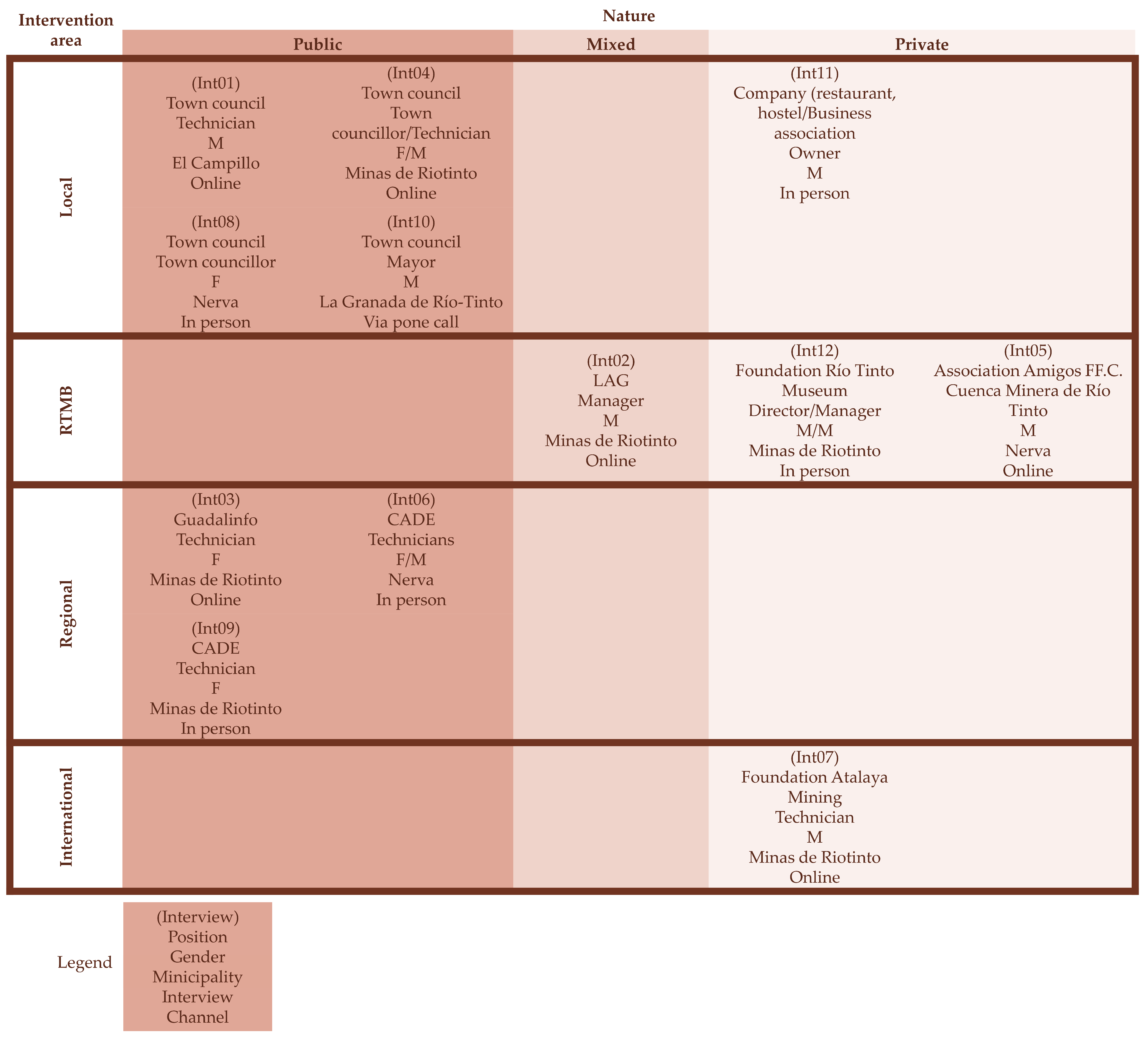

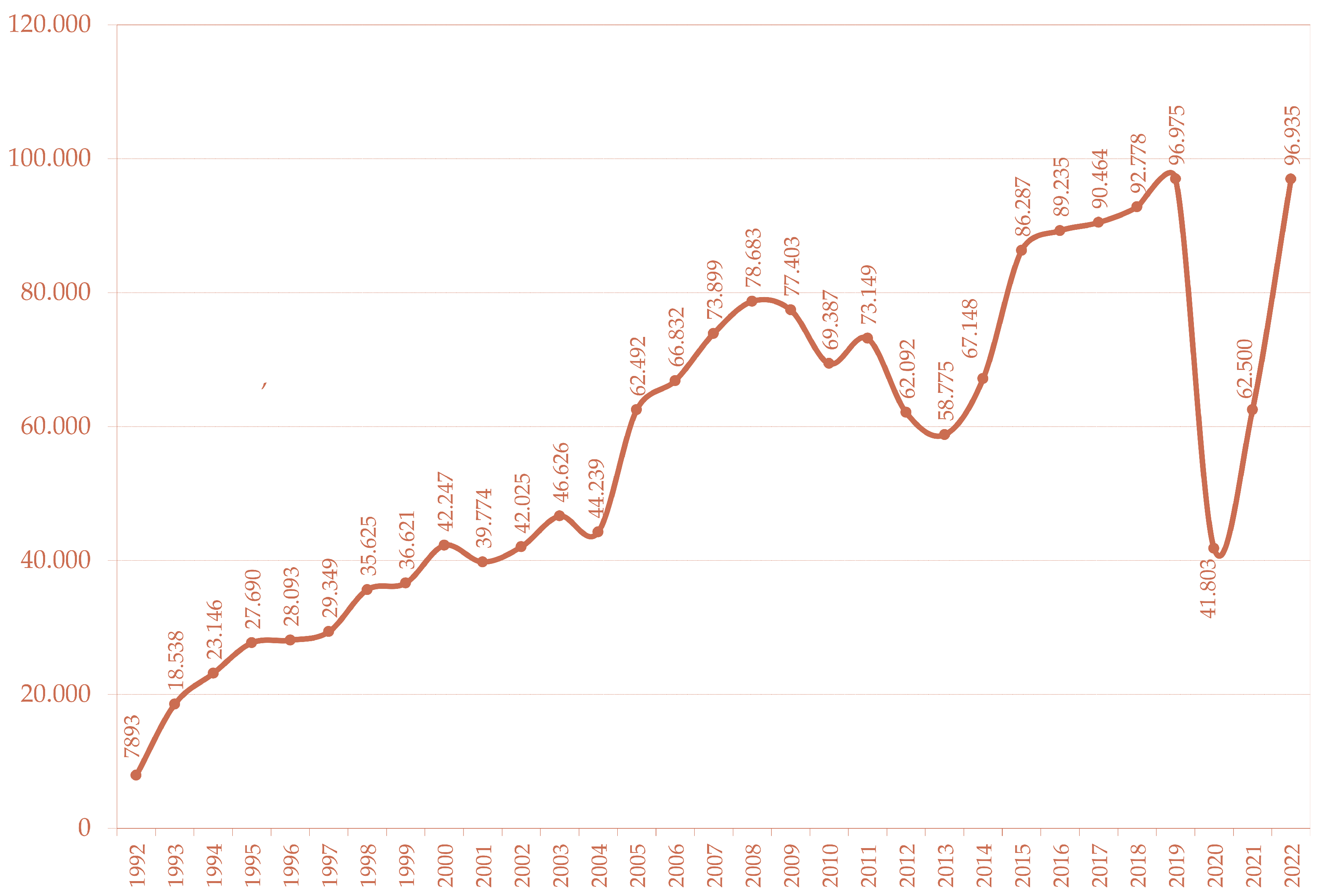
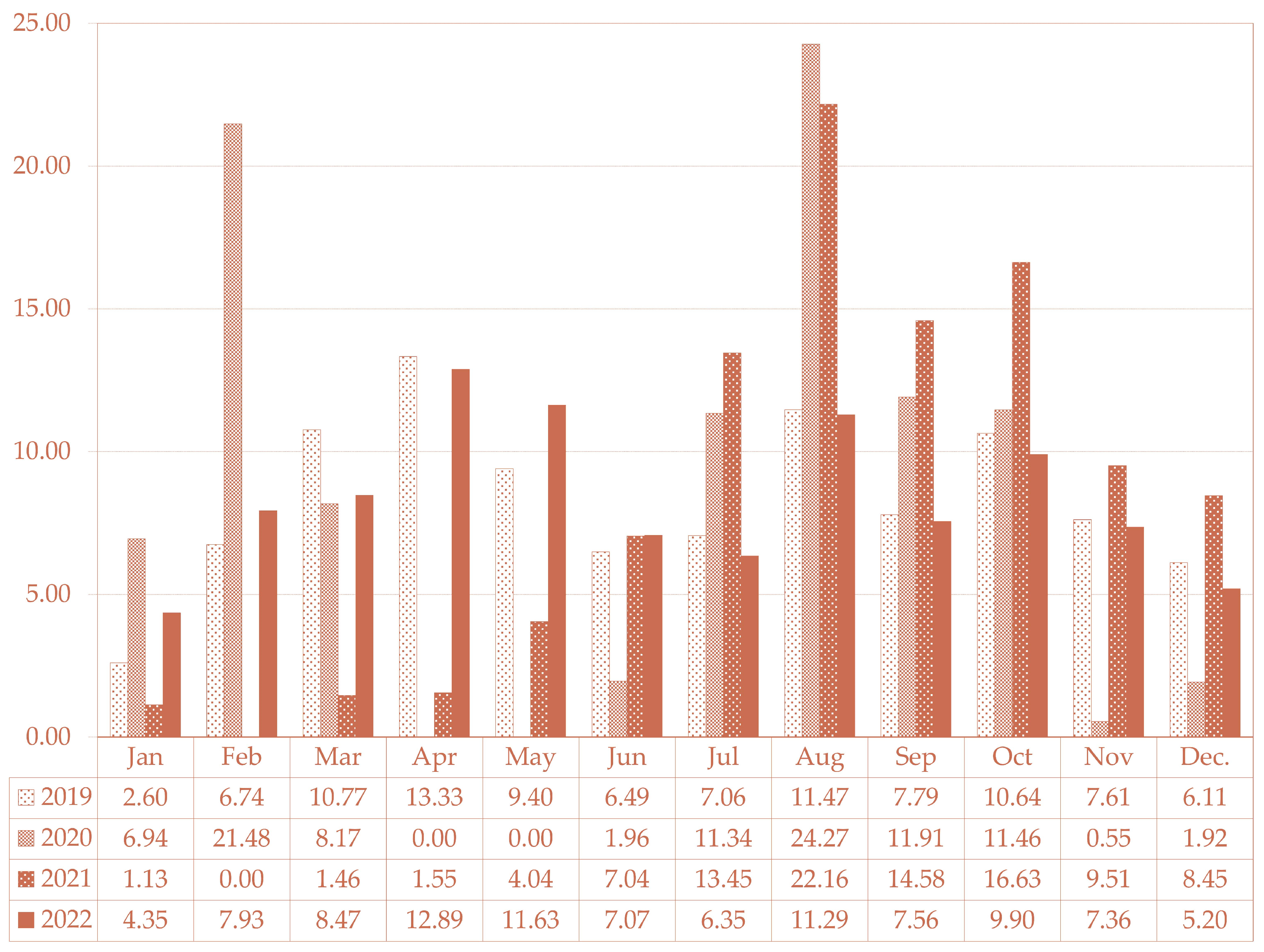
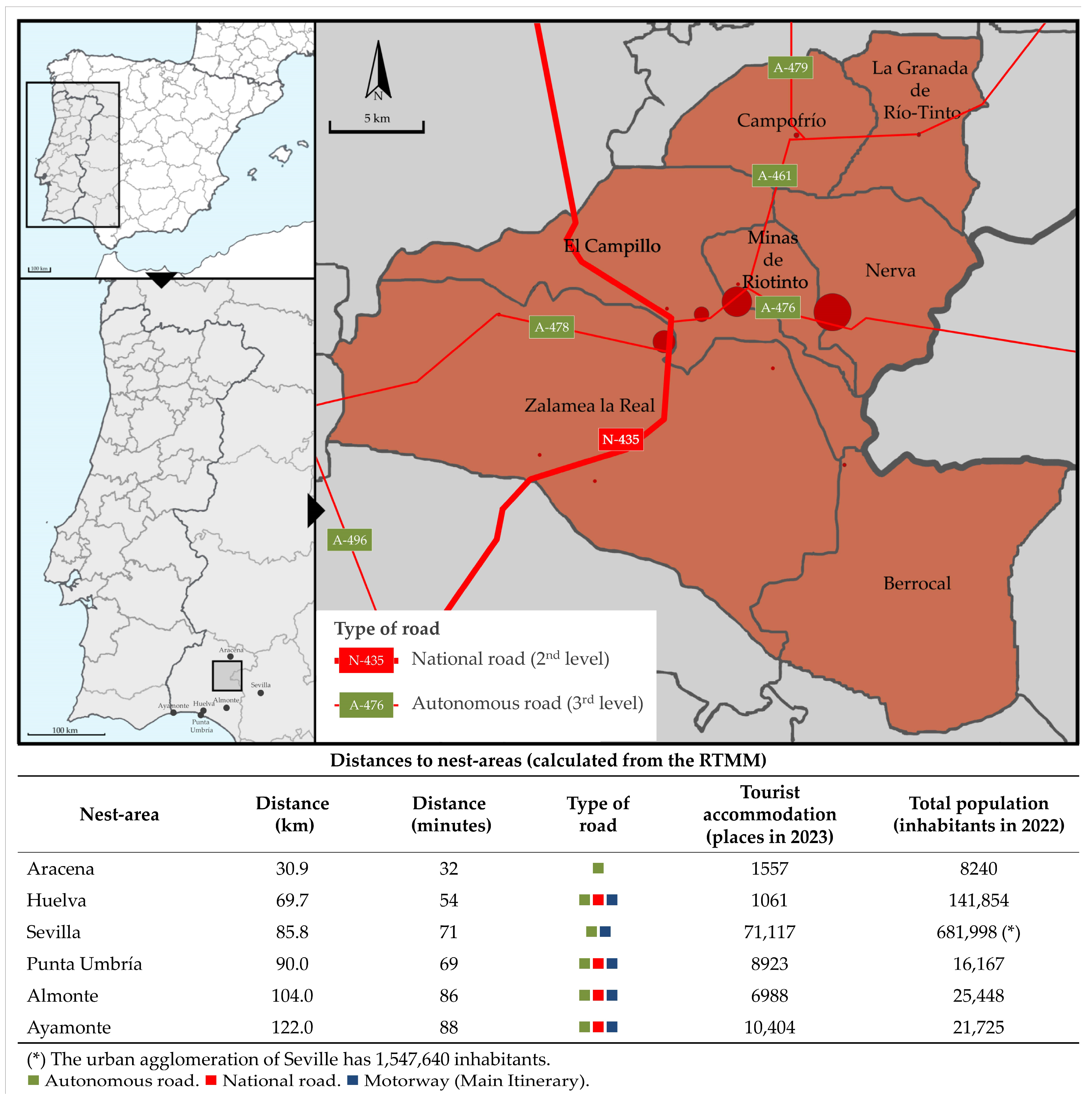

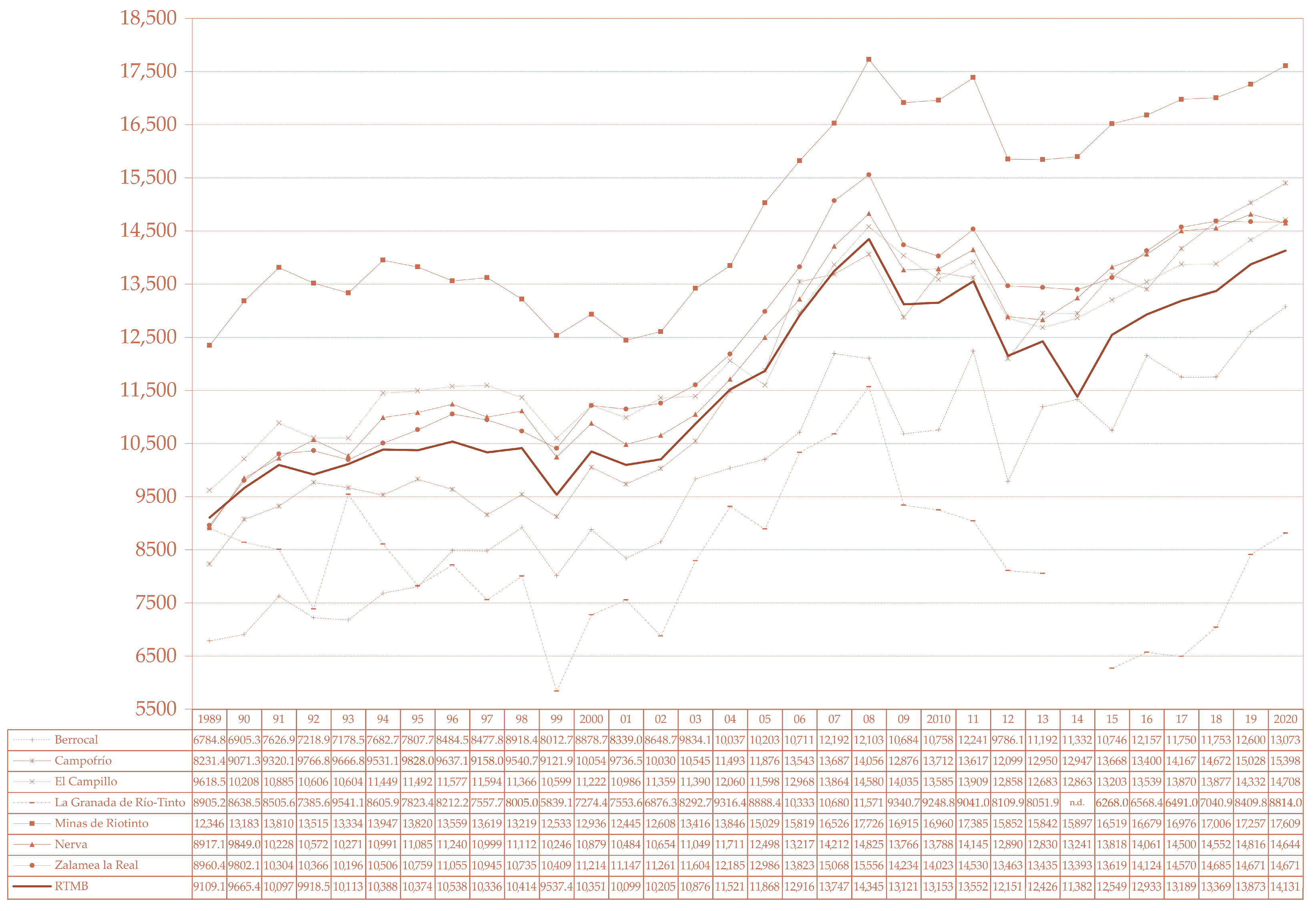
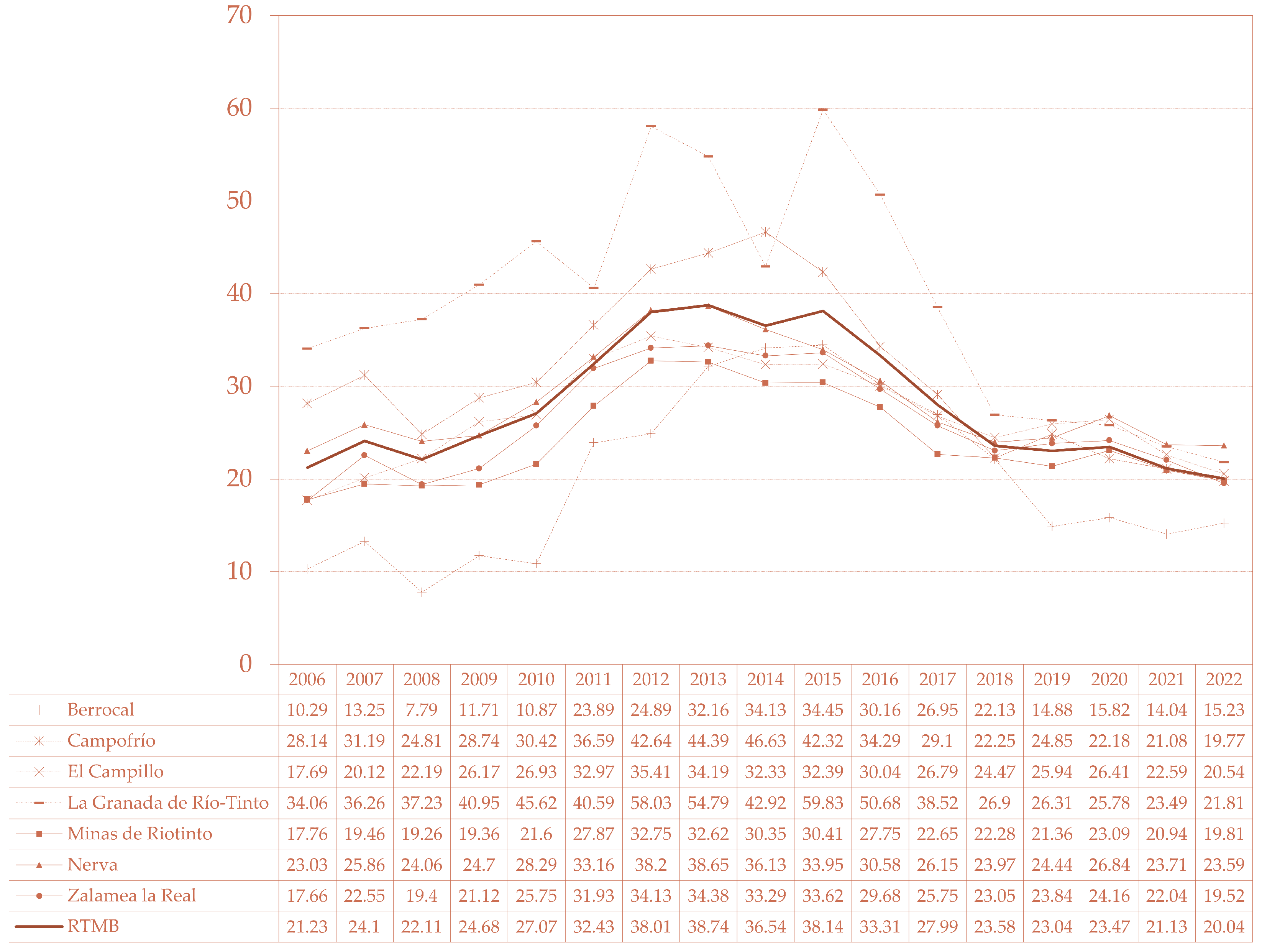
| Code | Question | Topics |
|---|---|---|
| q1 | What role does your entity have in tourism in the RTMB? | (a)(c) |
| q2 | Do you identify your territory with mining tourism? Why? | (a)(b)(c)(d) |
| q3 | What projects have you launched (or supported) for the heritage/tourism enhancement of the region/municipality? | (a)(b)(c) |
| q4 | What heritage projects/tourism enhancement does your entity plan (or intend to support) in the region/municipality? | (a)(b)(c)(d) |
| q5 | Who should we look to for the development of tourism? | (a)(b)(d) |
| q6 | What functions does the Río Tinto Foundation have in the destination? Which are, from your point of view, the most important? | (a)(b)(d) |
| q7 | What singularities does the mining tourism management model have in the region? | (b)(c)(d) |
| q8 | What are the instruments used for the development of mining tourism? | (b)(c)(d) |
| q9 | What is said about the promotion and development of tourist activities (companies and products) in the region? | (b)(c)(d) |
| q10 | What projects related to tourism (or not) have been launched in your municipality? | (b)(c)(d) |
| q11 | What is the future of mining tourism, given the reactivation of mining? | (a)(b)(c)(d) |
| q12 | What has been the situation of tourism activity during the COVID-19 pandemic? | (b)(c)(d) |
| q13 | Future proposals for improving tourism in the region. | (a)(b)(c)(d) |
Disclaimer/Publisher’s Note: The statements, opinions and data contained in all publications are solely those of the individual author(s) and contributor(s) and not of MDPI and/or the editor(s). MDPI and/or the editor(s) disclaim responsibility for any injury to people or property resulting from any ideas, methods, instructions or products referred to in the content. |
© 2024 by the authors. Licensee MDPI, Basel, Switzerland. This article is an open access article distributed under the terms and conditions of the Creative Commons Attribution (CC BY) license (https://creativecommons.org/licenses/by/4.0/).
Share and Cite
Bahamonde-Rodríguez, M.; Šadeikaitė, G.; García-Delgado, F.J. The Contribution of Tourism to Sustainable Rural Development in Peripheral Mining Spaces: The Riotinto Mining Basin (Andalusia, Spain). Sustainability 2024, 16, 443. https://doi.org/10.3390/su16010443
Bahamonde-Rodríguez M, Šadeikaitė G, García-Delgado FJ. The Contribution of Tourism to Sustainable Rural Development in Peripheral Mining Spaces: The Riotinto Mining Basin (Andalusia, Spain). Sustainability. 2024; 16(1):443. https://doi.org/10.3390/su16010443
Chicago/Turabian StyleBahamonde-Rodríguez, María, Giedrė Šadeikaitė, and Francisco Javier García-Delgado. 2024. "The Contribution of Tourism to Sustainable Rural Development in Peripheral Mining Spaces: The Riotinto Mining Basin (Andalusia, Spain)" Sustainability 16, no. 1: 443. https://doi.org/10.3390/su16010443
APA StyleBahamonde-Rodríguez, M., Šadeikaitė, G., & García-Delgado, F. J. (2024). The Contribution of Tourism to Sustainable Rural Development in Peripheral Mining Spaces: The Riotinto Mining Basin (Andalusia, Spain). Sustainability, 16(1), 443. https://doi.org/10.3390/su16010443






